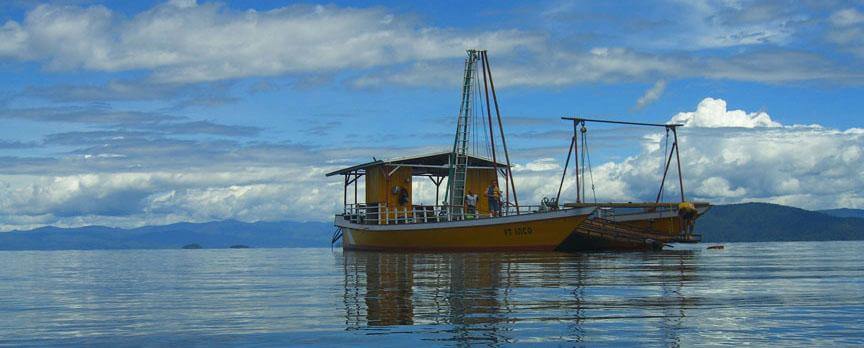A project aimed at sampling pristine sediments from deep beneath an ancient Indonesian lake is in full swing.
An international team of 40 scientists is drilling sediment cores from Lake Towuti on the island of Sulawesi. The sediments beneath the lake’s waters date back a million years or more and could help scientists reconstruct the climate history of a region that wields a weighty influence on climate conditions the world over.
Lake Towuti is the largest of a string of ancient tectonic lakes that dot the landscape of Sulawesi. “These lakes were identified 20 years ago as high-priority sites for a scientific drilling program,” said James Russell, a Brown University geologist and co-leader of theLake Towuti Drilling Project. “They’re big, they’re known to be very old, and they’re in a climatically important region of the world.”
The Indonesian archipelago sits within a pool of warm ocean that controls the Pacific El Niño oscillations, which can alter temperature and rainfall patterns across the Americas and elsewhere. The warm pool also supplies a substantial proportion of the water vapor in the Earth’s atmosphere. Water vapor is the planet’s predominant greenhouse gas, so the water supply coming from the Indonesian waters likely plays a key role in regulating global temperature.
“What we really want to know is, if you go back through time, how does the hydrological cycle of the biggest single source of global water vapor vary during periods of global climate change,” Russell said. “That’s a very important feedback to consider in thinking about past climate change as well as future prediction.” Russell, associate professor of earth, environmental, and planetary sciences, is a fellow of the Institute at Brown for Environment and Society.
The signatures of that hydrological cycle have been trapped over time in the sediment of Lake Towuti and are detectable in the sediment cores the researchers will gather. By looking at how concentrations of different chemical markers in the sediment change with depth, the researchers can develop a continuous record through time of how much surface runoff poured into the lake. The rate of runoff is directly related to the rate of rainfall.
A preliminary drilling operation completed in 2010 showed that changes in the hydrological record are indeed detectable. In the initial operation, Russell and his team cored about 30 feet into the sediment and recovered a record of about 60,000 years of rainfall. That work showed that during the last ice age, when glaciers covered much of the northern hemisphere, Indonesia dried out substantially. Rainfall during in the region during that period tailed off by as much as 50 percent, the researchers found.
“We’ve documented drought during one ice age, but there have been dozens of ice ages spanning the last million or so years,” Russell said. “We’d like to see if we can replicate that finding. As the Earth warms or cools, does Indonesia consistently become wetter or dryer?”
This new phase of the project could answer those questions. Rather than stopping at 30 feet, the Lake Towuti Drilling Project will drill all the way to bedrock, through as much as 1,000 feet of sediment and perhaps a million or more years of time. The information gathered on Indonesia’s hydrological cycle could then be used to test the predictions made by climate models and better predict future climate change.
While investigating climate is a primary goal for the project, it’s by no means the only one. These ancient lakes are home to scores of endemic species of plants and animals. Paleoecologists will look for clues about how the lake’s ecology has changed over time in response to a changing climate. The sediment layers are extremely low in carbon, silica, and phosphorus, but high in metals like iron, magnesium, nickel, and chrome. Scientists are investigating how microbes survive by ingesting these metals.
“No one has ever drilled into deep freshwater sediments like this to see what bacteria do in carbon-poor, metal-rich sediment,” Russell said. The work could help scientists learn to use such microbes to clean up mine waste or help shed light on how life may have existed in metal-rich environments like those on Mars.
The drilling will last about two months and run 24 hours a day. It is being done from a barge about 80 feet long and 24 feet wide, floating in water as deep as 650 feet. A local mining company called PT Vale Indonesia is providing logistical help with the drilling operation. The cores themselves come up in nine-foot sections, and a team of around 40 scientists is processing the cores as they come aboard, preparing them to be shipped to labs the world over for analysis.
Support for the effort comes from the International Continental Drilling Program, a multinational science organization headquartered in Potsdam, Germany, with logistical support from the GFZ German Research Centre for Geosciences. Additional financial support comes from the Indonesian government, the U.S. National Science Foundation, and the German and Swiss science foundations. The scientists will be posting updates throughout the operation on the project’s Facebook page.


